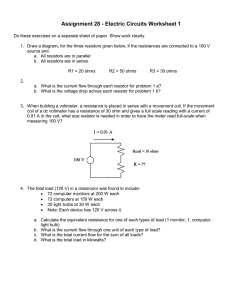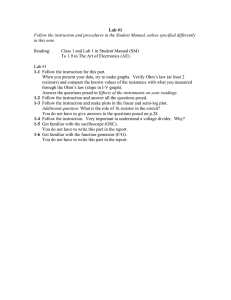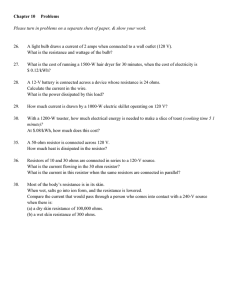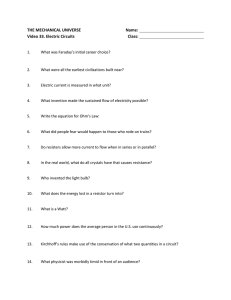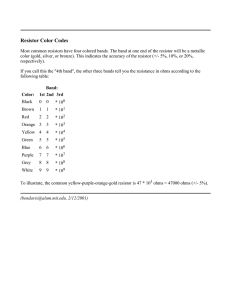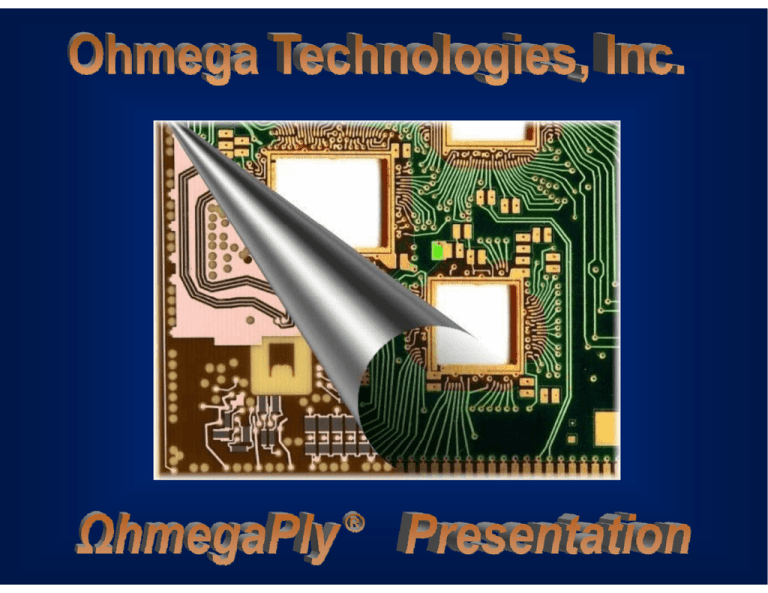
0
OhmegaPly® Embedded Resistor Technology
1. Electrodeposited thin film resistive material
2. Standard subtractive PWB processing
p
g
3 Surface or embedded resistors
3.
4 Mature technology (36+ years)
4.
5 Fi
5.
Field
ld Proven,
P
Excellent
E ll Long
L
Term
T
Reliability
R li bili
1
OhmegaPly® Manufacturing Overview
OhmegaPly® is a Nickel Phosphorous (NiP) metal alloy that is electrodeposited onto the
matte, or tooth side, of copper foil. The thin film NiP metal alloy/copper foil combination is
g y RCM (RESISTOR-CONDUCTOR
(
MATERIAL).
) The RCM is laminated
called OhmegaPly
to a dielectric material (like any other copper foil) and subtractively processed to produce
copper circuitry and planar resistors. Because of its thin film nature, it can be embedded
within layers without increasing the thickness of the board or occupying any board surface
area as is
i required
i d for
f discrete
di
t chip
hi resistors.
it
COPPER
COPPER
ELECTROPLATING
RCM
NICKEL
PHOSPHOROUS
LAMINATION
OHMEGAPLY®
LAMINATE
2
OhmegaPly ® Sheet Resistivity Offerings
Sheet
Material
Resistivity Tolerance
10 /□
3%
25 Ω/
50 Ω/
100 Ω/
250 Ω/
5%
5%
5%
10%
Typical
Applications
Developed for series termination resistors as ORBIT (Ohmega Resistors Built In Trace) and also used for other applications, like flexible heaters
Used primarily for series/parallel termination resistors and power dividers
Used primarily as pullup/pulldown resistors for electronic logic circuits
g
pp
High ohmic applications
3
Recommended Copper Types
Low Profile
Modified Low Profile
PTFE
Hi Tg Epoxy
Rogers Duroid®
Polyimide
Arlon CLTE
Lead-Free
Ohmega/Faradflex ®
Rogers 4003
Flex
Ceramic-Filled
LCP (Rogers Ultralam)
25 ohm per square at 200X
25 ohm per square at 200X
4
Advantages of OhmegaPly®
A.
Electrical Advantages
1. Improved line impedance matching,
2. Shorter signal paths and reduced series inductance,
3. Eliminate the inductive reactance of the SMT device,
4. Reduced cross talk, noise and EMI
B.
PCB Design Advantages
1. Increase active component density & reduced form factors,
2. Improved wireability due to elimination of via.
3. Improved reliability due to elimination of solder joints.
C.
Improved Reliability
1. Low RTC of <50 PPM (-55 ° C to 125 ° C)
2. Life testing:
g 100,000
,
hours = +2% at 110° C
3. Stable over wide frequency range: tested beyond to 40+ GHz.
4. Lead-free compatible
D
D.
Economic Advantages
1. Elimination of discrete resistors
2. Improved assembly yield
3. Board densification and/or size reduction
5
Advantages of PRT
D.
Economic Advantages
4. Board simplification (double sided SMT to single sided SMT;
potential
i l layer
l
andd via
i count reduction
d i )
5. Deliver tested board to the assemblers
E.
Minimal Risk
1. Over 36 years of use
2. Predictable
– Design: Know how to achieve target with simple formula (L/W x Rs)
– Process: Know how to characterize and compensate
– Linear relationship: increase 10% resistor length equal to 10% increase in
resistance value
– Yield: standard distribution, tolerance drive yields
3. Proven longg term reliabilityy
6
PCB processing of OhmegaPly®
A. Step-By-Step Processes and Required Chemistries.
STEP 1: Apply Photoresist to
Laminate
STEP 2: Print and Develop
Composite Image
STEP 3: Etch Unwanted Copper
Using Any Conventional Etchant (1st
etch)
STEP 5: Strip Photoresist
STEP 6: Apply Photoresist, Print
STEP 7: Etch Away Copper Over
and Develop Conductor Protect Image the Designed Resistor Using a
(2nd print)
Selective Alkaline Etchant (3rd etch)
STEP 4: Etch Unwanted Resistive
Material with Copper Sulfate
Solution (2nd etching process)
STEP 8: Strip Photoresist
7
Distribution of OhmegaPly® Resistor Values
10 OHMS
40%
30 OHMS
35%
50
0 OHMS
30%
100 OHMS
25%
1Kohm
20%
5 Kohm
15%
10 Kohm
10%
5%
0%
100 K ohm
TERMINATING
PULL - UPS
Resistor Type
1 (Ohm s)
8
Ohms Per Square
Sheet resistivity (stated in Ohms per square) is dimensionless
• A square area of resistive material = sheet resistivity of resistive material
E g a 25 /
E.g.,
/(Ohms/Square)
(Ohms/Square) sheet resistance
L1 = W1
N1 = 1
R1 = 25 Ohms
•
L2 = W2
N2 = 2
R2 = 25 Ohms
L3 =W3
N3 =3
R3 = 25 Ohms
Resistor
R
i t value
l = sheet
h t resistivity
i ti it x ratio
ti off element
l
t length
l th to
t width
idth (R =Rs
R x L/W)
E.g., a 25 / sheet resistivity
Length = 0.030” (30 mils)
Width = 0.015 “ (15mils)
Resistor value = 25 / x (30mils/15mils)
= 25 / x 2 squares = 50 ohms
9
Ohms Per Square
150
330
50
Termination and pull-up resistors in an ATM switching card.
10
Recommended Power Density
POWER DENSITY OF 10-250 OHM/SQ. MATERIAL VERSUS
DIFFERENT RESISTOR AREA 25 C AMBIENT
1.2000
10 Ohm/Sq.
Powe
er Density (mW
W/mil 2)
1.0000
25 Ohm/Sq.
0 87
y = 76.5x
76 5 -0.87
50 Ohm/Sq.
0.8000
y = 61.2x -0.87
100 Ohm/Sq.
250 Ohs/Sq.
y = 54.5x -0.87
0.6000
y = 45.9x -0.87
0.4000
y = 39.7x -0.87
0.2000
0.0000
0
100
200
300
400
500
600
700
800
900
1000
1100
R i t A
Resistor
Area ((mil
il 2)
11
Recommended Power Density
POWER DENSITY OF 10-250 OHM/SQ. MATERIAL VERSUS
DIFFERENT RESISTOR AREA AT 100°C AMBIENT
600
10 ohm/sq
ohm/sq.
25 ohm/sq.
500
50 ohm/sq.
y = 65.52x
65 52x-0.87
Pow
wer Density (m
mW/mm2)
100 oh/sq.
400
250 ohm/sq.
y = 52.42x-0.87
300
y = 46.65x-0.87
y = 39.31x-0.87
200
y = 34.07x-0.87
100
0
0.00
0.10
0.20
0.30
0.40
Resistor Area (mm2)
0.50
0.60
0.70
12
Resistor Footprint Calculator
A - DESIGN SPECIFICATION
Please enter the resistance value (R ) in Ohm, power rating (P) in milliWatt, and maximum tolerance
(t ) in percent for each desired resistor (R 1 , R 2 , R 3 , R 4 & R 5 ) in table 1 below, and exit the cell
to allow the pprogram
g
performs
p
the calculations.
R1
Resistance Value ((R)) in Ohm
Power Rating (P) in mW
Maximum Tolerance (t) in %
R2
22
65
12
R3
33
65
12
1255
125
12
R4
R5
1000
000
125
15
4700
700
125
15
Table 1. For designer to enter the resistance, power rating and percent tolerance values of desired resistors
B - RECOMMENDED MINIMUM WIDTH AND LENGTH OF DESIRED RESISTORS
Sheet
R1
R2
R3
R4
R5
Resistivities
W1
L2
W2
L2
W3
L3
W4
L4
W5
L5
(Ohm/Sq.)
(Mil)
(Mil)
(Mil)
(Mil)
(Mil)
(Mil)
(Mil)
(Mil)
(Mil)
(Mil)
10
25
50
100
11.0
21.0
33 0
33.0
55.0
24.2
18.5
14 5
14.5
12.1
10.0
18.0
25 0
25.0
40.0
33.0
23.8
16 5
16.5
13.2
250
433.0
38.1
300.0
39.6
t*
t*
tt*
t*
P*
t*
t*
tt*
t*
t*
8.0
12.0
18 0
18.0
32.0
100.0
60.0
45 0
45.0
40.0
105.0
52.5
t*
t*
P*
P
P*
t*
6.0
7.0
70
7.0
11.0
600.0
280.0
140 0
140.0
110.0
19.0
76.0
t*
t*
tt*
P*
P*
6.0
7.0
70
7.0
7.0
2820.0
1316.0
658 0
658.0
329.0
15.0
282.0
t*
t*
tt*
t*
t*
Table 2. The recommended minimum width and length
g for each desired resistor which is calculated byy the program
p g
base on the given
g
values by the designer in table 1.
13
Standard CAD Layout Tools
OhmegaPly resistor design is compatible with standard CAD
tools. Instructions are available for OhmegaPly
g y design
g in:
1.
2.
3.
4.
5.
Mentor
Allegro
Intergraph,
g p , Classic
Pad’s Power PCB
VeriBest
14
Ohmega Resistor Built in Trace (ORBIT®)
15
Ohmega Resistor Built in Trace (ORBIT®)
22 ohms resistor
Enlargement of ORBIT as series terminating resistors.
16
Ohmega Heaters
OhmegaPly® as a heater element
Advantages are:
• Low
L Power
P
R
Requirement
i
• Fast Heat Rise
• Excellent Thermal Stability
- 0.7 % change in resistance after 500 hours at 200 ºC
17
OhmegaFlexTM Heaters
TE
EMPERATURE RISE C
C
TEMPERATURE RISE VERSUS POWER DISSIPATION
of 10 ohm/sq OhmegaFlexTM Series C Circular Heaters
270
240
210
180
150
120
90
60
30
0
A
B
C
D
0.0
1.0
2.0
3.0
4.0
5.0
6.0
POWER DISSIPATION (WATT)
TEMPERATURE RISE VERSUS POWER DISSIPATION
of 10 ohm/sq OhmegaFlexTM Series C Arc Heaters
CIRCULAR HEATERS
HEATER RESISTANCE APPLIED D.C
POWER TEMPERATURE TEMPERATURE
( ) CURRENT (Amp) DISSIPATION (W)
No.
RISE (C)
RISE TIME (Sec)
I2
I3
P1
P2
P3
T1
T2
T3 Time1 Time2 Time3
A
4.7
0.32 0.64 0.96 0.48 1.91 4.31 40 100 180* 60
60
30
B
4.8
0.21 0.46 0.71 0.21 1.01 2.41 35
85 170* 40
60
30
C
4.3
0.19 0.51 0.79 0.15 1.13 2.69 36 107 165* 35
40
60
D
4.2
0.14 0.52 0.81 0.09 1.15 2.75 45 125 160* 36
35
30
ARC HEATERS
240
TEMPERATURE RISE C
I1
270
210
180
F
120
G
90
H
60
E
112
0.004 0.13 0.18 0.001 1.75 3.57 36 150 264
30
30
60
30
F
182
0.05 0.12 0.16 0.45 2.66 4.95 52 165 250
30
30
60
0
G
150
0 07 0.16
0.07
0 16 0.21
0 21 0.67
0 67 3.84
3 84 6.83
6 83 53 175 250
30
40
60
H
147
0.07 0.16 0.20 0.68 3.92 6.12 47 135 195
40
40
60
* Maximum operating temperature
E
150
0.0
1.0
2.0
3.0
4.0
5.0
6.0
7.0
8.0
POWER DISSIPATION (WATT)
18
OhmegaFlexTM Heaters
TEMPERATURE RISE VERSUS POWER DISSIPATION
of 10 ohm/sq OhmegaFlexTM Series S Rectangular Heaters
270
TEM
MPERATURE RISE C
240
210
1
180
2
150
3
120
4
90
5
60
6
30
0
0.0
1.0
2.0
3.0
4.0
5.0
6.0
7.0
8.0
POWER DISSIPATION (WATT)
RECTANGULAR HEATERS I1
I2
I3
P1
P2
P3
TEMPERATURE RISE VERSUS POWER DISSIPATION
of 10 ohm/sq OhmegaFlexTM Series S Serpentine Heaters
TEMPERATURE
RISE TIME (Sec)
T1
T2
T3 Time1
Ti 1 Time2
Ti 2 Time3
Ti 3
0.11 0.22 0.67 0.06 0.22 2.00 34
58
230
40
45
60
1
4.5
2
9
0.17 0.33 0.48 0.25 1.00 2.05 56 134 220
35
35
60
3
26
0.12 0.23 0.35 0.35 1.38 3.12 55 125 215
35
50
60
4
33
0.12 0.24 0.36 0.48 1.94 4.36 60 133 210
45
50
45
5
60
0.07 0.22 0.33 0.27 2.82 6.67 40 135 220
45
40
60
6
65
0.08 0.25 0.34 0.38 3.94 7.45 50 122 183
40
50
40
SERPENTINE HEATERS 7
62
0.03 0.13 0.18 0.06 1.03 1.95 32 135 202
30
30
30
8
342
0.05 0.10 0.13 0.95 3.58 5.66 63 158 225
30
30
50
9
435
0.04 0.10 0.11 0.74 4.06 5.30 52 157 185
30
40
35
10
475
0.05 0.10 0.11 1.42 4.45 6.14 50 107 135
30
45
30
270
240
TEMPERATURE RISE C
HEATER RESISTANCE APPLIED D.C POWER
TEMPERATURE
( )
No.
CURRENT (Amp) DISSIPATION (W)
RISE (C)
210
180
7
150
8
120
9
90
10
60
30
0
0.0
1.0
2.0
3.0
4.0
5.0
6.0
7.0
8.0
9.0
10.0
11.0
POWER DISSIPATION (WATT)
19
Applications for Ohmega Heaters
OhmegaPly
Heater
element
OhmegaPly
Heater
element
20
OhmegaPly® Resistor Designs
Surface resistor application –Potentiometer (35 mm SLR camera).
21
OhmegaPly® Resistor Designs
MEMS Microphone
22
OhmegaPly® Resistor Designs
Interposer board.
23
OhmegaPly® Resistor Designs
Parallel termination resistors in a BGA package.
24
OhmegaPly® Resistor Designs
Series termination resistors in a BGA package.
25
OhmegaPly® Resistor Designs
Pull-up resistors in an avionic application
26
OhmegaPly® Resistor Designs
Buried resistor application – 2” X 3” Probe Card.
27
OhmegaPly® Resistor Designs
Series termination resistors for telecom switching card
28
OhmegaPly® Resistor Designs
OhmgaPly® Resistors in Flex Circuit
29
® Flex Circuit Applications
OhmegaPly
Ohmega-Ply RCM® Ni-P Embedded Resistors
MULTILAYER FLEX TAPE APPLICATIONS
35 mm Tape BGA - 1mm Pitch
Reel to Reel Process Capability
ETCHED RESISTOR TOLERANCES
Nominal Value - ohms:
25
37.5
50
75
100
Aspect ratio (# of squares):
R i
Resistor
width
id h - mils:
il
Resistor Length - mils:
1
8
8
1.5
8
12
2
8
16
3
8
24
4
8
32
Mean value (ohms)
Percent tolerance
35 ohms 44 ohms 54 ohms 78 ohms 105 ohms
+/- 50% +/
+/
+/- 25% +/
+/- 20% +/
+/- 15% +/
+/- 10%
Ohmega-Ply RCM®1/2R25
{Half ounce - 25 ohms/square} Resistive -Conductive-Material
Note:
Percent tolerance decreases with resistor width and length.
Mean value can be corrected by artwork compensation.
30
OhmegaPly® Resistor Designs
1
2
3
0.060’’ CLTE
4
5
6
0.060’’ CLTE
FIRST LAMINATION
CLT CORE MATERIAL
VENDER COPPER
PLATED COPPER
OHMEGA LAYER
55NI PREPREG
ABLEFILL
SPEEDBOARD
OhmegaPly® resistor in microwave application
for Globalstar antenna.
7
8
FINAL LAMINATION
Figure 8 – Layer stackup.
31
OhmegaPly® in Microwave Applications
0.026” x 0.0145
Enlargement of a four-up array 16-way power divider with 50 /sq
OhmegaPly® resistors
32
OhmegaPly® in Microwave Applications
Insertion Loss vs Frequency
q
y
Rogers 0.020" RT/d 6202 with four copper types
0.00
-0.02
Av
verage dB / inc
ch
-0.04
-0.06
-0.08
-0.10
Ohmega
lowReverse
profile copper
Ohmega on
treated foil (smooth)
Ohmega
low profile
Ohmega modified
on high profile
ED foilcopper
(rough)
-0.12
-0.14
1/2 oz. Rolled (smooth)
1/2 oz. ED (rough)
-0.16
Calculated smooth
-0.18
Calculated rough
-0.20
0.0
2.0
4.0
6.0
8.0
10.0
12.0
Frequency, GHz
33
OhmegaPly® in Microwave Applications
INSERTION LOSS vs FREQUENCY
ARLON 0.030
0 030 " CLTE-XT
0.000
Average dB/inch
A
h
-0.050
-0.100
1oz ED (control)
-0.150
OhmegaPly 1R25 modified low profile
OhmegaPly 1A50 ultra low profile
-0.200
OhmegaPly 1R25 low profile
1oz RT (control)
-0.250
2.0
5.0
10.0
15.0
20.0
25.0
30.0
35.0
40.0
Frequency (GHz)
34
Mars Express with OhmegaPly® in Beagle 2 Lander
Lander
PAW
Mars Express orbiter
Beagle 2 Lander with instruments on
its robotic arm
Ohmega-Ply® resistors on inner layer
X-Ray Spectrometer with cover to
measure the elements in rocks
All images all Rights Reserved Beagle 2
Ohmega-Ply® resistors in electronic
lander PC board
Ohmega-Ply®
resistors on
inner layer of
boards
X-Ray Spectrometer (XRS) with
Ohmega-Ply
g
y® resistors
XRS
Electronic
lander PC
board
Top view of PAW (position
adjustable workbench)
April, 2003
35
Application of OhmegaPly® on Lead-Free Dielectrics
▲ OhmegaPly® Resistors on Inner Layer of DRAM Design
OhmegaPly®
Resistors
▲ Enlargement of Above Design
36
Application of OhmegaPly® on Lead-Free Dielectrics
•
•
•
•
•
•
•
Resistive stability after solder float (%R)
Thermal stress test-to-failure
test to failure.
Compare FR4 to a “Lead-Free” laminate.
Test at T260 20 seconds versus T288 10 seconds.
Preconditioning; baking versus no-baking
Failure means resistor becomes unstable or open.
Th result
The
lt was that
th t the
th lead-free
l d f laminate
l i t was clearly
l l
superior at T288. Surviving 25 cycles.
37
Application of OhmegaPly® on Lead-Free Dielectrics
Results of Lead-Free Assembly Simulation
SUBSTRATE % ∆R AT % ∆R AT % ∆R AT % ∆R AT
% ∆R AT
1 CYCLE 2 CYCLE 5 CYCLE 10 CYCLE 15 CYCLE
FR-4
-0.36
-0.47
-0.47
Lead Free
Lead Free
FR-4
FR-4
-0.57
-0.27
-1.39
-1.25
-0.58
-0.37
open
open
-0.62
-0.46
-0.54
-0.27
-0.24
-0.16
% ∆R AT
20 CYCLE
-0.13
0.17
% ∆R AT TEST METHOD
25 CYCLE
T260. 20 sec
-0.08
0.26
T288, 10 sec
T288, 10 sec
T288, 10 sec
T288, 10 sec
CONDITION
no bake
5 hr bake
no bake
5 hr bake
no bake
Memory board, 10 layers with one layer of 22 ohm resistors, 23 mils x 10 mils.
Built using Double Treat 1/2A50ohm OhmegaPly NiP laminate.
The FR-4 PCB used a standard multifunctional epoxy laminate.
The "lead-free" PCB used a phenolic-cured laminate.
Testing per IPC-TM-650, Method 2.4.13.1, baking was performed at 125 dC.
38
OhmegaPly® Reliability Data
A.
OhmegaPly® Specifications and Properties
OhmegaPly® has been used in numerous applications for over 30 years; exhibiting excellent performance and
dependability.
p
y Due to its absolute long-term
g
reliability
y under a varietyy of severe environmental conditions,, OhmegaPly
g y® is
used in numerous critical products (space-base, aerospace, avionics, etc.) where the utmost in reliability is required.
The estimated failure rate for OhmegaPly® resistors is less than 0.001 resistor elements per 1 million operating hours (this
is based on test results where over 1 trillion component hours have been accumulated without a field failure). Field
failure is defined as resistor failure that is caused by the resistive material itself, and not other sources of printed circuit
board failure (opens, shorts, defective base material, excessive power surges, improper operating conditions, etc.).
®
OHMEGAPLY RCM PROPERTIES AND SPECIFICATIONS
Sh t R
Sheet
Resistivities
i ti iti
Material Tolerance
Load Life Cycling Test
( R%)
10
25
50
100
250
+/-3
+/-5
+/-5
+/-5
+/-10
Ambient Temp: 70C
0.5
On Cycle: 1.5 hrs
(after 1000 hrs) Off Cycle: 1.5 hrs
Length Of Test: 10000 hrs
<0.3
(after 1087 hrs)
<5
<5
<5
<-16
<-15
<-15
<-15
<-15
Short Time Overload (R%)
0
0
0
0
0
Resistance Temperature
p
Characteristic(RTC)
20
50
60
100
100
Current Noise Index in dB
PPM/°C
Remark and Condition
Voltage Applied: 10 ohm/sq.: 53.2V
25 ohm/sq.: 5.6V, 100 ohm/sq.: 7.9V
Power:2.5 X Rated
Time: 5 sec
Hot Cycle: 25°, 50°,75° 125°C
Cold Cycle: 25°, 0°,-25°, -55°C
39
OhmegaPly® Reliability Data
®
OHMEGA-PLY RCM PROPERTIES AND SPECIFICATIONS
Sheet Resistivities
10
25
50
100
Remark and Condition
250
Humidity Test (R%)
Thermal Shock (R%)
Hot Oil (R%)
Solder Float ( R%)
0.3
0.5
0.75
1
2
0.1
-0.5
1.0
1.0
1.0
--
0.1
0.25
0.5
0.75
0.2
0.5
0.75
1.0
0.5
MIL-STD-202-103A
Temp: 40 °C
Relative Humidity: 95%
Time: 240 hrs
MIL-STD-202-107B
No of Cycles: 25
H t Cycle
Hot
C l Temp:
T
125 °C
Cold Cycle Temp: -65 °C
IPC-TM-650 METHOD 2.4.6
Temp: 260°C
Immersion: 20°C
MIL STD 202 210D
MIL-STD-202-210D
Temp: 260°C
Immersion: 20 Second
Resistance to Solvent
( R%)
Toluence 1-1-1:
Trichloroethan:
Acetone:
Freon:
Capacitance(pF) (at 5 Hz)
Inductance (nH) (at 5 Hz)
MIL-STD-202-215A
Immersion: 15 mins
N/A
~0
< ~0.6
0.2
0.0
0.2
0.0
~1
< ~0.6
N/A
N/A
N/A
~1
< ~0.6
~1
< ~0.6
~1
< ~0.6
B. OEM Long Term Reliability Test Data
1. Cray Research
In a study of the stability of buried OhmegaPly® resistors used for ECL termination
termination, Cray concluded that the
®
OhmegaPly resistors “would operate well beyond all normal voltages and temperatures, and there have been no
reports of a resistor failure due to resistive material.” Cray Research also found that incorporating the OhmegaPly®
40
OhmegaPly® Reliability Data
resistors into the internal plane of a multilayer board substantially improved the signal quality for high speed devices. Cray
Research used OhmegaPly® in millions of multilayer circuit boards since 1982 with absolute field reliability of the
resistive elements.
2. Alcatel Bell
Researchers at Alcatel Bell tested OhmegaPly® resistors for broadband (45 MHz-5 GHz) telecom applications to
compare the reliability of OhmegaPly® to 0805 discrete thick film chip resistors rated at 125mW. OhmegaPly was as good
as, or better than, the chip resistor in all performed tests.
Type of Test
Humidity Test
Temp:
p 40 °C
Relative Humidity: 93%
Thermal Cycling
Hot Cycle Temp: 125 °C
Cold Cycle Temp: -25 °C
Aging Wihout Load
Temp: 125 °C
Solder Heat/Float
Temp: 260 °C
Immersion: 20 sec
Measured max./min. R
(Alcatel Tested)
After 21 days:
0.22% for 25 Ohm/sq.
q
0.07% for 100 Ohm/sq.
0.10% for 250 Ohm/sq.
After 56 days:
0.74% for 25 Ohm/sq.
0 14% ffor 100 Oh
0.14%
Ohm/sq.
/
0.22% for 250 Ohm/sq.
After 100 Cycles
- 0.03 % for 25 Ohm/sq.
0.03 % for 100 Ohm/sq.
- 0.08 % for 250 Ohm/sq.
After 100 Hrs.
0.10% for 25 Ohm/sq
0.08% for 100 Ohm/sq
- 0.13% for 250 Ohm/sq
- 0.02% for 25 Ohm/sq
0.01% for 100 Ohm/sq
- 0.01% for 250 Ohm/sq
Ohmega Specifications Thick film chip R (0805)
After 10 days:
0.5% for 25 Ohm/sq.
q
After 56 days:
≤ ± 1.5%
1.0% for 100 Ohm/sq.
After 25 Cyles
- 0.5% for 25 Ohm/sq.
1% for 100 Ohm/sq
≤ ± 25%
Not specified
Not specified
0.5% for 25 Ohm/sq
1% for 100 Ohm/sq
≤ ± 25%
41
OhmegaPly® Reliability Data
3. IBM
IBM built and tested a numbers of evaluation boards that incorporated OhmegaPly® into multiple internal layers of a
multilayer design. This effort was to see what effect, if any, there was on the assembly (and rework) process due to the
embedded resistors
resistors. In addition
addition, standard environmental stress testing was performed (including thermal cycling,
cycling thermal
shock, vibration testing and torque testing). The findings of their published report showed “no significant resistance
change on the resistors from the assembly process and stress test”.
4. Unisys
In evaluating the long term drift characteristics of OhmegaPly® on high Tg, low DC substrate, Unisys concluded that
powered (22 mA), Ni-P buried resistors, fabricated using ammoniacal etch process and fully aqueous resist, when placed
in a 55 C cabinet environment, will drift < 2 % in 100,000 hours (11.4 years).
5. Dassault (Thales)
(
)
Dassault Electronique did a 2 year study of OhmegaPly® for an active phased array antenna (X-band). The resistors were
used in a stripline configuration a PTFE substrate (Rogers RT Duroid® 6002 and fusion bonded inside a multilayer
package). Ohmega-Ply® was compared to chip resistors and screen printed polymer inks. OhmegaPly® was selected for
use due to superior tolerance and stability (compared to printed polymer inks) and space saving, parasitic reduction, and
solder joint removal (compared to chip resistors). The results of testing are as follows:
Etching
Minimum
Tolerance Resistor Width
5%
200 m
Tolerance After
Influence of Ohmega-
Shift of Resistor Thermal Coefficient of
Fusion Bonding
Ply Foil Layer on
Microwave Properties
Values After 500 Resistance Within the Handling performance of two ports
Thermal Cyles Range (-55°C, +125°C)
power divider, when
( 55° C
(-55°
C,+125°
+125° C)
Oh
Ohmega
F
Foil
il Technology
T h l
7%
NO
Microstrip: +2%
Stripline: +3%
Microstrip: ± 6%
Stripline: ± 7%
Power
300 mW
No shift in microwave
is tested under the
following conditions:
• 500 thermal cycles
(- 55° C, +125° C)
• 500 hours
ou s at 125°
5 C
• 40 days 40° C, 95% RH
• 48 hours salt spray
42
OhmegaPly® Reliability Data
6. Rogers Corporation
In an internal study, Rogers evaluated OhmegaPly® resistors on polyimide /Pyralux®. They found the following
change in a resistor that was 0.25” x 4.0” in size with a flex radius of 0.25” (the flex rate was 10 cycles/minute):
* With Coverlay
Number of Flex Cycles
150
1,500
10,000
250 000
250,000
% Change in Resistance
0.5
6.1
25.5
0 0*
0.0*
7. Delphi Delco Electronics Systems
In evaluating material for the Advanced Embedded Passives Technology (AEPT) project,
project Delphi Delco performed ESD test on
embedded resistors and capacitors in PWB, and OhmegaPly® was chosen as benchmarks for resistor. The resistance changes
after 8kV discharge for OhmegaPly® is shown in table A. The results indicated that OhmegaPly is ESD stable for the testing
voltage range from 2kV to 8kV.
OhmegaPly
Oh
Pl ®
Resistor Width
% change in
resistance
10 mil
20 mil
40 mil
50 mil
0.10
-0.51
-0.37
0.09
Resistance change after 8 kV ESD discharge.
43
OhmegaPly® Reliability Data
8. OhmegaPly for lead-free assembly. Highly Accelerated Thermal Shock Test (HATS)
CHANGE IN RESISTANCE AFTER
C
G
SS
C
1000 000 C
CYCLES
C S
Resistor Network % change in Resistance Test Result
Test Condiltion
1
0.20
Pass
15 Coupons Per Resistor Network
y
2
0.15
Pass
Total Cycle Time: 10.85 minutes
3
0.20
Pass
High Temperature: +145 C
4
0.17
Pass
Low Temperature: ‐40 C
High Temperature Extended Dwell Time: 0.25 minutes
L T
Low Temperature Extended Dwell Time: 0.25 minutes
t
E t d d D ll Ti
0 25 i t
44
OhmegaPly® Cost Analysis
A. Traditional Cost Model (direct replacement of discrete resistor with Ohmega-Ply)
Volume:
®
2
g y Material ((Cents/in )
OhmegaPly
Board Convesion Cost Adder
Prototype
Low
Medium
High
$0.20
$0.40
$0.14
$0.25 - $0.30
$0.10
$0.15 - $0.20
$0.07
$0.11 - $0.15
TYPICAL BOARD COST ADDER PER LAYER OF VARIOUS (DISCOUNT) LEVELS
80
Discrete Resistor Cost
At $0.01/Discrete
70
At $0.05/Discrete
Ohmega-Ply Cost Adder
Prototype
60
Low Volume
50
Centts/in
2
Medium Volume
High Volume
40
30
20
10
0
0
2
4
6
8
10
12
14
16
18
20
Component Density/in2
45
OhmegaPly® Cost Analysis
B. Technology Tradeoff Cost Model (enhanced PCB design using OhmegaPly® to replace
discrete resistors)
Following is a comparison of some board technologies (per square inch of board area)
area). The
comparison is based on an application requiring 10 resistors per square inch of board area:
Substrate type
Standard 6-layer with SMT
Standard 6-layer with Ohmega
Microvia 4-layer with SMT
Sequential build 66-layer
layer
(buried vias with SMT)
Cost addder
substrate
Total cost
bare board
SMT cost
(resistor)
Total cost, bare
board + resistor
--$0.20
$0.46
$0 49
$0.49
$0.12
$0.32
$0.58
$0 61
$0.61
$0.20
--$0.20
$0 20
$0.20
$0.32
$0.32
$0.66
$0 81
$0.81
Use of OhmegaPly® in design may:
• Reduce board area
• Reduce layer count
• Allow for discrete SMT to become single side SMT
• Improve loaded board testability
• Allow for more traditional PCB technology (through hole versus HDI)
46
Summary and Conclusions
1
1.
Thi Fil
Thin
Film Resistive
R i ti Material
M t i l
2.
Standard Subtractive PWB Processingg
3.
Surface or Embedded Resistors
4.
Mature Technology (36+ years)
5.
Field Proven, Excellent Long Term Reliability
6
6.
Performance Enhancing,
Enhancing Cost Effective Resistor
Technology in High Speed/High Density Circuit Designs
47
OHMEGA TECHNOLOGIES, INC.
4031 ELENDA STREET
CULVER CITY, CA 90232-3799
PHONE: (310)559-4400
FAX: (310)837-5268
WEB SITE: http://www.ohmega.com
Version 2.4
Copyright 2010 Ohmega Technologies, Inc.
Rev 1110
48


